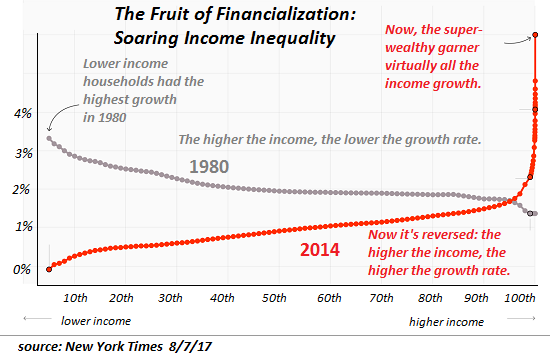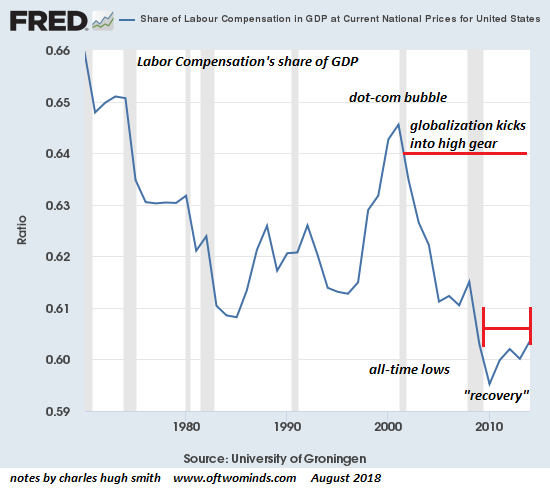Capital garners the gains, and labor’s share continues eroding. That’s the story of the 21st century. The middle class, virtually by definition, is not prepared for downward mobility. A systemic, semi-permanent decline in the standard of living isn’t part of the implicit social contract that’s been internalized by the middle class virtually everywhere:living standards are only supposed to rise. Any decline is temporary. Downward mobility is the key context in the gilets jaunes “yellow vest” movement in France. Taxes and prices rise inexorably while wages/pensions stagnate. The only possible outcome of this structural asymmetry is a decline in the standard of living. This structural decline in the standard of living
Topics:
Charles Hugh Smith considers the following as important: 5) Global Macro, Featured, newsletter, The United States
This could be interesting, too:
Nachrichten Ticker - www.finanzen.ch writes Die Performance der Kryptowährungen in KW 9: Das hat sich bei Bitcoin, Ether & Co. getan
Nachrichten Ticker - www.finanzen.ch writes Wer verbirgt sich hinter der Ethereum-Technologie?
Martin Hartmann writes Eine Analyse nach den Lehren von Milton Friedman
Marc Chandler writes March 2025 Monthly
 Capital garners the gains, and labor’s share continues eroding. That’s the story of the 21st century.
Capital garners the gains, and labor’s share continues eroding. That’s the story of the 21st century.Another way to understand this downward mobility is: the elites no longer need a vibrant middle class to hold power and increase their wealth. The real money is in globalized capital flows, access to central bank credit and ownership of debt. The role of the middle class has largely been reduced to being compliant, passive debt-serfs who can borrow money to fill the yawning gap in their standard of living and make the payments.
| For an example of how this works, please read I’ve Paid $18,000 To A $24,000 Student Loan, & I Still Owe $24,000 (via Maoxian).Since the political machinery serves the oligarchy, there’s no real need to pander to the middle class or the working class. Being tossed in with the politically invisible hurts the pride of the middle class, as does being expendable, but as we see in this chart, the top .01% have skimmed the vast majority of whatever wealth and income have been generated over the past decade.
Whatever crumbs fell to the middle class must have been sufficient, as they’re still paying their mortgages, student loans, auto loans, etc. |
The Fruit of Financialization 1980-2014 |
| The general decline in living standards tracks the general decline in labor’s share of the economy:
Capital garners the gains, and labor’s share continues eroding. That’s the story of the 21st century. |
Labor Compensation's share of GDP 1980-2010 |
Tags: Featured,newsletter


